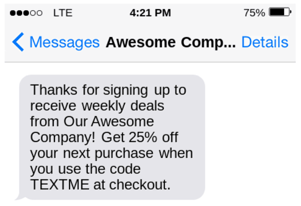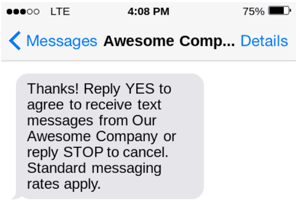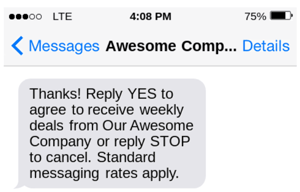
It’s important to know how to use text messaging for effective marketing, keeping compliance in mind. According to the TCPA (Telephone Consumer Protection Act), your business must gain explicit consent from your audience before communicating with them via text.
Here’s the step-by-step process for compliant text message marketing, including some real-world and SMS marketing examples that you can use as inspiration for your own SMS campaigns:
Step 1: Get signups
Step one is to attract consumers to receive text messages from you. This can be done in a number of ways. Use other channels where you communicate with customers — billboards, email, online ads — to find them where they are. Then, it’s best practice to draw in users with some kind of incentive. Offer to send them exclusive deals or promotions or give your text-based list special advantages like sneak peeks, free swag or other perks.
The trick with this is to make it clear what you’re offering them in return for signing up to receive texts from you. And, it’s critical to make the signup process as simple and painless as possible. Choose an easy-to-remember phone number they can text to sign up.
Another important best practice to follow when creating your sign-up incentive is to make sure your keyword is pulling its weight. Sometimes JOIN, as in “Text JOIN to 52225,” is all you need. But you can put on your marketing hat and get creative as well.
Here are a few examples of sign-up incentives:



Your customers are signing up to get texts from you because they are interested in something you’re offering them. What better way to ensure customer satisfaction than to deliver on that offer immediately. Exclusive access or a special deal for new sign-ups can make customers feel like their choice to subscribe to your SMS campaign is worth it.
Here’s an example of how you can deliver on your offer once you have your opt-in:

Step 2: Double opt-in
Once you’ve properly incentivized your audience enough to get some signups, you may want to get a double opt-in. Though only one opt-in is required for consent, many brands choose to obtain explicit consent from customers again in their first text to make sure communication is completely transparent. This is called a double opt-in and it’s the best practice for making sure you’re compliant with the law and not spamming customers.
The intent here is to cover your legal bases and make sure that customers are 100% clear that they’re agreeing to receive text messages from you. Having them reach out first and then reply with their explicit consent is a good best practice to ensure you’re legally compliant.
Here is an example of language you can use in your first opt-in text message to customers:

Another way to cover your bases is to be clear and upfront with your audience about how often you’re going to message them and with what types of content. You could mention that you’re planning to text them deals once a week or monthly tips — either way, this is a method to ensure complete transparency. The more transparency your text campaign offers, the less likely your messages will come across as spammy and be ignored or reported.
If you want to go the extra mile for the sake of clarity, here’s how we can modify that first message to add the relevant information:

Step 3: Measure
Measure the engagement and test what works and doesn’t work with your audience. As in all things marketing, A/B testing is a great way to gather information on what plays best with your audience. But you should also be measuring the results of your campaign in terms of open rate, sign up rate, and engagement for each campaign to ensure that you’re optimizing your text marketing budget.
Keeping an eye on your metrics can also help you keep your SMS list accurate and up-to-date, ensuring that you’re steering clear of spamming your customers and, instead, sending them texts they appreciate and even enjoy.



